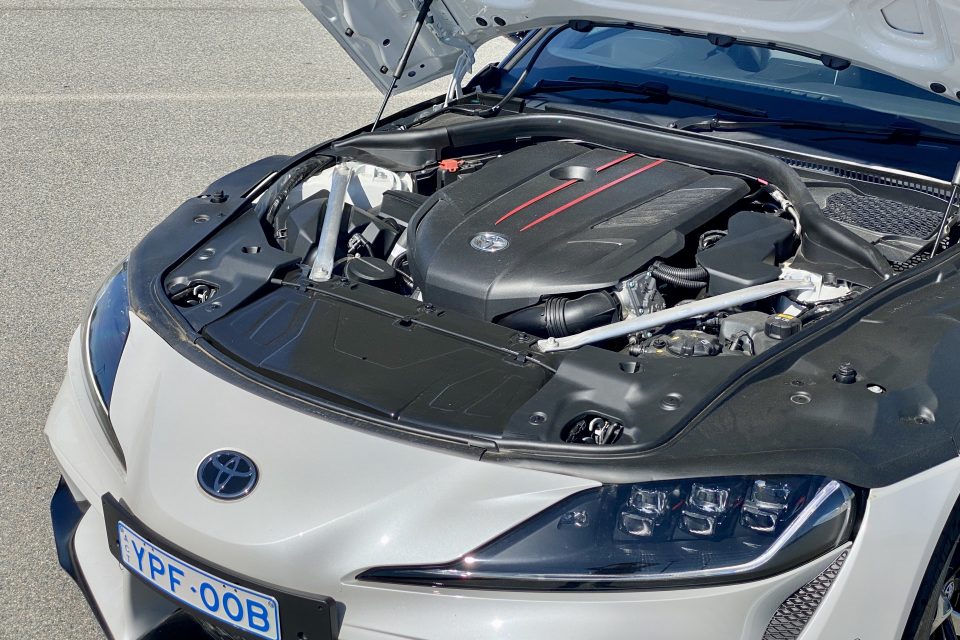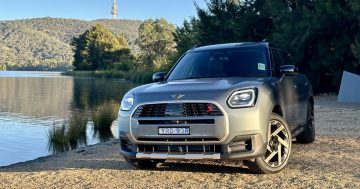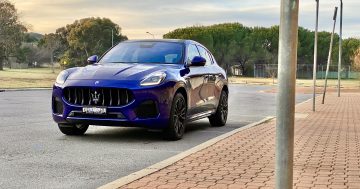
The Toyota Supra: you get a lot of German kit at a Japanese price. Photo: James Coleman.
The name ‘supra’ is derived from a Latin prefix meaning ‘above’, ‘to surpass’ or ‘go beyond’. Super, basically.
So far, so boring, but ‘Supra’ has become a hallowed name among car enthusiasts as an icon of the empty car park, the race track, and the bedroom wall poster alike. Even Paul Walker drifted around in one in the 2001 film, The Fast and the Furious.
The news now is that after 28 years, the Toyota Supra is back. And I’m currently putting it through its paces in a traffic jam on Yamba Drive, trying to remember that the indicator stalk is on the left.
Yes, that’s right. The Japanese icon might be back, but it isn’t all that Japanese anymore.

Preparing for take-off. Photo: James Coleman.
The Supra cult traces its origins back to 1978 when Toyota stretched the front end of the existing Celica so they could fit a stonking great inline-six-cylinder engine under the bonnet. The result was dubbed the Celica XX or Supra.
It wasn’t until 1986 that the Supra cut ties with the Celica and became a model in its own right. A turbocharger arrived a year later.
Production wound up three successful generations later in 2002.
Neighbourhoods across the world then started to grow progressively louder as fans tried to quench the insatiable appetite for a new Supra by fitting their current ones with canon exhausts, turbos the size of air-conditioning units and ridiculous body kits.
But then a spark of hope was lit in 2014 when the sheets were ripped off a front-engined, rear-wheel-drive sports coupe called the FT-1. Despite Toyota’s attempts to douse the rapidly spreading rumours, internet sleuths and motoring magazine editors touted this concept car as a preview of the next Supra.
The idea of a resurrection wasn’t without its sceptics, though. Toyota simply didn’t have the hardware to make it happen, many said.
However, no one counted on Toyota knocking on the door of BMW and asking very nicely if they could perhaps, borrow their 3-litre twin-turbo inline six-cylinder engine. And while we’re on it, maybe they could also throw in the eight-speed automatic gearbox and rear-wheel drive system too? And forgive the boldness, but would the entire cabin be too much to ask?
Open the bonnet and a plastic shroud advertises the fact a bit of money was involved in the deal with the Germans, enough for Toyota to stamp it with their logo. But closer inspection reveals that someone at the factory forgot to tear all the BMW tags off.
There are many who criticise this whole arrangement, arguing that the new Supra is hardly the halo car for Toyota it once was, the same way sushi would cease to be Japanese if it were made of liverwurst.
But regardless of what you think of the contents, the skin is definitely the traditional sushi seaweed. The curves, the shapes, and that ducktail spoiler certainly have people looking.







The only trouble is the number of fake vents scattered about the body, which is the second thing everyone will notice, and then draw attention to with loud, incredulous tones.
But don’t be fooled by the black plastic. The Supra is very much still a sports car.
It’s a petite but hefty thing, with meaty steering and sure-footed handling. This year’s update brings a slightly faster 0 to 100 km/h time too, now 4.1 seconds.
It is very jiggly and my head says that this is exactly how a sports car should be, but on some sections of our lumpy roads, my back did disagree. However, everything can be adjusted at a few touches of the screen, so you can always just slip everything into ‘comfort’ and sit back and enjoy the jam.

Basically, it’s a BMW Z4 inside, but with a different logo on the steering wheel. Photo: James Coleman.
It also isn’t very graceful to get into, requiring careful thought as to whether it’s your feet or bottom that have to go in first. Once in, it’s a snug interior. The windscreen is quite small and steeply raked, which didn’t do wonders for my claustrophobia, but the view out over the bonnet and out the back lets you know you’re at the heart of something special.
Press the start button, and boy, does this heart start beating too. The noise is, perhaps unsurprisingly, very similar to the BMW M3 I drove recently, and there isn’t really a quiet mode either.
Returning home in the evening had a young boy in my apartment complex rushing outside, thinking that a Lamborghini had graced the carport with its presence. Nope, just me in the white Toyota, painstakingly threading it through the poles. The Supra might be small, but it isn’t exactly easy to park.
At this point, you probably think the new Supra costs a bomb, and you’re busily researching markets that sell firstborn children. Not so. The top-of-the-line GR GTS model in ‘Fuji White’ costs $105K driveaway. To put that into perspective, the BMW Z4 starts at $130K.
That’s a cheap BMW.

Behold the ducktail. Photo: James Coleman.
2021 Toyota Supra GR GTS
- $105,491 driveaway
- 3-litre inline-6 cylinder twin-scroll turbo petrol, 285 kW/ 500 Nm
- 8-speed automatic (with manual mode), rear-wheel drive
- 0-100 km/h in 4.1 seconds
- 7.7 litres per 100 km combined fuel usage.
Visit Canberra Toyota for more information.





















